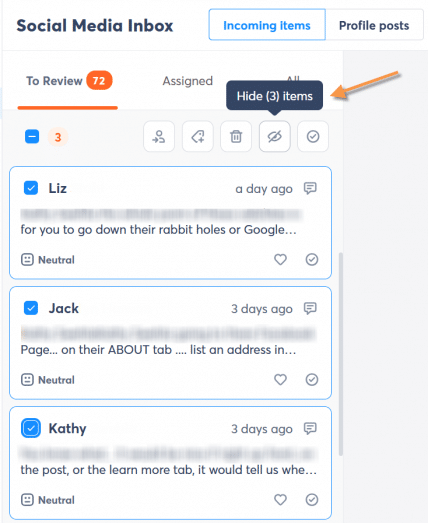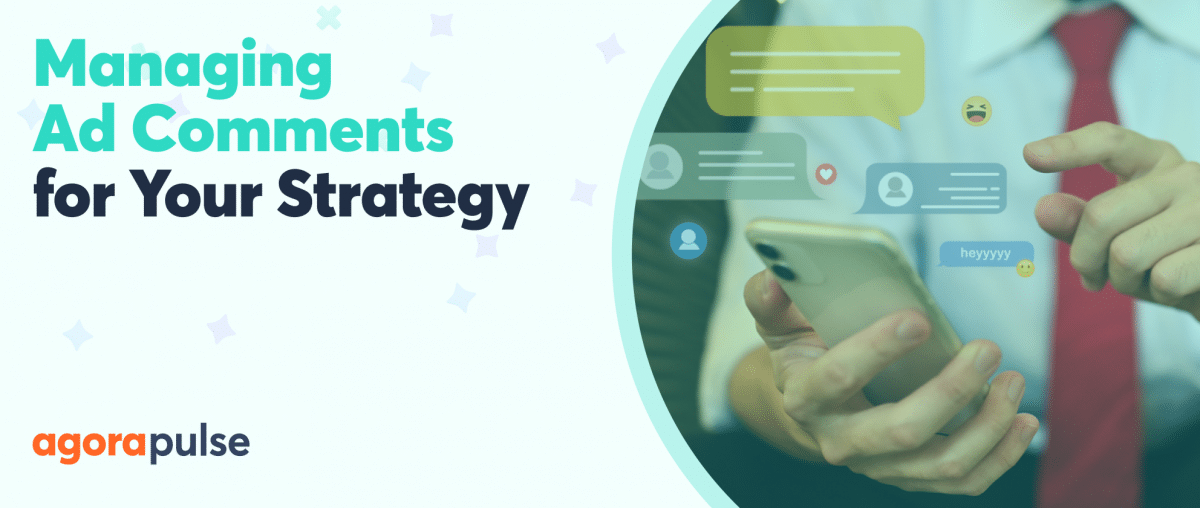Social media comments: Where customer service meets public theater. Every day, your team faces an inbox full of praise, complaints, and random crypto messages. Those who take the time to leave a comment expect a quick reply—and so does everyone else who follows your page.
Social media moderation shapes your brand’s reputation and drives business growth. The right strategy and tools help you focus on conversations that matter.
Ready to improve your social media moderation? Start your free Agorapulse trial today
The Art and Science of Managing Social Comments of All Stripes
Sure, responding to comments is polite. But it’s also a good business strategy whether you answer comments on organic or paid posts.
Organic post comments build community. If you handle these comments appropriately, you’ll maintain momentum and encourage more interaction.
Paid social comments affect ad performance. Because social media algorithms consider comment sentiment, negative comments can impact your reach. Quick, professional responses protect your advertising investment and increase your ad ROI in ways that lookalike audiences and the perfect headline length can’t.
>Let’s dive into properly managing good, bad, and head-scratching comments left on organic and paid posts.
Everyday, generally positive comments
Most comments on social media come from a good place. These comments show customer interest, enthusiasm, and genuine engagement with your brand.
Customers leave positive comments to:
- Share their experiences
- Ask about products
- Thank your team
- Connect with your brand
- Show support
The Golden Rule applies to responding here. Do you like prompt, helpful responses from brands online? Then, provide the same service to those who comment on your posts.
And put on your marketing hat. Consider how their positive comments can create opportunities to strengthen relationships and gather valuable feedback.
Say someone comments to share their experience. Thank them, but also ask for more details. Later, with the user’s permission, you can turn your conversation into a potential testimonial, UGC, or social proof content.
Negative feedback
Negative comments stink. But they’re also incredible opportunities to show the world how good your customer service is. Future customers watch how you handle criticism through your comments!
Here’s how Melissa’s Produce handles someone on Facebook who didn’t care for one of their products.
Here are a few suggestions to take once you spot negative comments:
Respond promptly. Quick responses prevent escalation. They show you’re listening and find their feedback valuable.
Acknowledge the concern. A reply like “We understand your frustration about (issue)” shows you’re really listening.
Take ownership of the issue and offer clear next steps. Tell the commenter (and everyone else watching) that you can provide a solution. “We’ve sent you a DM with a return label. You should have it within 5 minutes.”
Move heated conversations to private channels. Speaking of DMs, if the back-and-forth is on the brink of getting into a shouting match, or if other users are chiming in, tell the original commenter that you’ll reach out to them via direct/private message or email. (Somewhere where it’s not dangling for the world to see and reply to!)
Spam and Inappropriate Comments
Let’s address the head-scratching, “Huh?” type of comments.
Every social media manager knows them: the crypto offers, the sus links, the flurry of emojis. If left unchecked, these comments can distract from the social presence you want and harm your brand reputation.
This commercial spam usually wants one thing: your attention. Don’t give it to them. Delete it and move on. Paging Okta on Instagram!
Harmful content, including hate speech, harassment, or content that violates platform policies, requires immediate action. Remove these comments quickly and document patterns of abuse.
Trolling needs a nuanced approach. Sometimes, what looks like trolling is a frustrated customer in disguise. Take a moment to check the commenter’s history with your brand before deciding how to respond. If it’s genuine trolling, don’t engage—that’s exactly what they want.
Strategic comment management turns social interactions into business gold. When applicable, reply in a way that builds loyalty, gathers insights, and demonstrates your brand’s commitment to customer experience.
Building a Killer Content Moderation System
You’ve got the strategy. Now, you need the right tools to make your job easier.
A solid content moderation system helps you manage high comment volume, catch problems early, and keep your team organized. Here’s how to use a social media management tool to make moderation manageable and effective.
Set up filters
Content moderation systems work best when you can literally “filter through the noise” in your social media inbox. Social media management software can help you find the conversations you want to address first.
Agorapulse lets you search for those conversations in a way that makes sense—whether by comment type, keyword, sentiment, label, or date of publication. (Not many tools out there give you all these options!)
Look for social media management software that supports an inbox for ad comments so that you can respond to feedback left on posts you put money behind. Agorapulse gives users comments for Facebook, Instagram, LinkedIn, and TikTok ad comments.

Navigate Spam and Inappropriate Content
Inbox filters are great for finding positive comments. Automation rules and comment moderation options are fabulous for finding (and eliminating) less-than-desirable ones.
Depending on the social network, Agorapulse lets you build simple automation to remove or hide spam phrases and links. What a way to keep your personal inbox and public comments clean!
If you want more granular control over spammers and trolls, use your inbox’s bulk delete feature to instantly remove annoying or potentially harmful comments.
Are you unsure whether a particular commenter is a spammer or a troll? Check out the user profile conversation history to see what past comments this person has left.
If you discover this user has a history of trolling or sending spam, you can ban them directly from a Facebook or YouTube user profile or unfollow them from X/Twitter.
Create Saved Replies
Do you dread typing the same reply to commonly asked questions in your inbox comments? Then, build saved replies to relieve you of that drudgery.
These response templates allow placeholders to customize personal details and reference specific customer comments.
Start by writing saved replies to common product questions, shipping status updates, and tech support questions. You’ll think of more saved replies ideas as you dig into your inbox features a bit more.
Collaborate with Ease (and Results)
Make sure your content moderation system allows you to manage comments as a team easily.
To ensure you and a teammate aren’t replying to the same message simultaneously, you’ll want a command center like Agorapulse with a collision detection feature.
To automate collaboration, use Agorapulse’s automated rules. Designate keywords that will instantly send comments to your colleague who’s best prepared to answer them.
Got a comment in Spanish? Have it sent to your LATAM rep.
Got a question about pricing? Send it to your product marketing manager.
You get the idea.
Outdoor furniture retailer Fermob has streamlined its social media engagement with Agorapulse using many features we’ve just described.
Want to try it for yourself? Take a 30-day free trial.
Prioritizing Conversations
Once you’ve gotten the spam and trolls out, what’s next? What’s your game plan for replying to all those comments?
You must create a prioritization matrix if you’re hard-pressed to answer those questions.
High-Priority Comments
Start by reviewing high-priority comments. These need immediate (or near-immediate) feedback.
Product safety issue. If you get a comment like, “OMG. How loose are the buttons on your SoftSleep PJs? I just noticed a missing button … found in my 6-month-old’s hand,” you should respond quickly. A speedy reply will set that customer at ease and show those who read this comment thread that your company cares deeply about product safety.
Purchase-blocking questions. Time is money (lost) with limited-time deals. So, if someone asks in a comment, “Does this come in size 10?” during a flash sale, answer them post-haste. Your answer will also help others who seek the same size.
Viral potential situations. Watch for comments that are getting tons of engagement. Whether comments explode for good reasons (“Wut? Just saw Madison Beer talking about you.) or bad reasons (Third price increase in a year? Not cool.), address these hot comments before they spread.
Medium-Priority Comments
Take a step back with medium-priority conversations. These aren’t mission-critical but should be answered within a few hours. Here are a few comment types that can be considered medium priorities.
General product questions. A potential customer might ask, “Does this come in size 10?” as we reviewed in the high-priority comments. In both situations, this comment shows purchase interest. But your response is not time-critical if this question is being asked outside of a time-boxed offer.
Competitive comparisons. Your reply here will influence the original commenter and other potential buyers, so respond tactfully. Focus on your special sauce when someone asks, “How are you different from [product X]?” and avoid putting down the competitor.
Low-Priority Comments
These comments can wait until you have time. They matter but won’t impact your business if they have to sit for a day.
They’re typically great candidates for your Killer Content Moderation System’s saved replies. Here’s a sample of low-priority comment types.
General praise. When someone drops a “Love your stuff!” comment, thank them when you can. Your response might encourage more positive feedback or ask for specifics, but it’s not time-sensitive.
Extremely common questions. When someone asks something that’s already answered in your FAQs, bio, or pinned post, point them to the right resources when your schedule allows.
Simple acknowledgments. A comment like “YES!” doesn’t need an immediate reply. It doesn’t even need a text reply. A quick like, reaction, or emoji can do the trick here.
Here’s how Bubble Skincare handles the positive, low-priority comments on TikTok.
Good prioritization will help you stay sane when wading through comments. Think of comment moderation like triage—treat the serious cases first, but make sure everyone gets care eventually.
Ready to Streamline Comment Moderation?
Clear priorities, intelligent automation, and a human face with a marketing brain turn comment moderation into great business opportunities.
Set up a system that works for your team, focus on what matters most, and watch those comments turn into real business value.
Ready to streamline your social media moderation? Start your free Agorapulse trial today.














